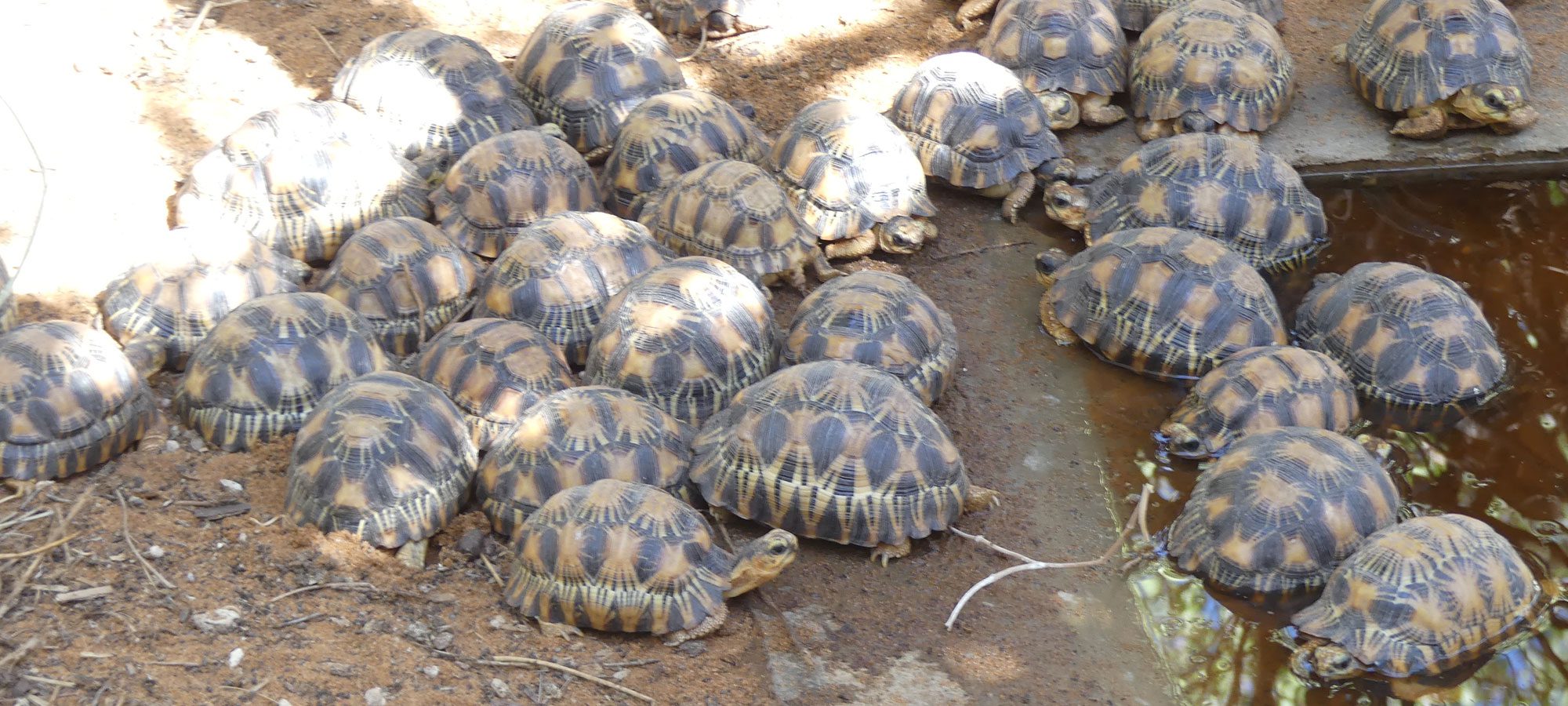Radiated Tortoises are critically endangered and are listed as a threatened species in the WA (Washington Convention on International Trade in Endangered Species) Appendix I. In the IUCN Red List the species is classified as Critically Endangered (CR). The IUCN bases its assessment on a generation time of 42 years. Over a period of 67 years, which is less than two generations, this species has disappeared from 40 percent of its habitat. With continued high levels of exploitation of wild populations, Astrochelys radiata will inevitably become extinct in the wild in the near future.
Hazard from humans
Adult Radiated Tortoises have no natural enemies in the wild, other than humans. Hatchlings of Astrochelys radiata are occasionally eaten by birds of prey, snakes, lizards, crabs, and small mammals of the Eupleridae family and spiny lobsters. Nevertheless, the species is severely threatened in its existence. The following human-caused factors contribute significantly to the decimation and extinction of the species:
Protection and offspring programs
Although the overexploitation of endemic animals and plants as well as the destruction of habitats in Madagascar continues at an alarming rate, the species conservation of Astrochelys radiata seems to be secured through targeted breeding programs in reserves and national parks as well as zoos and meanwhile also on a private level. Of great importance and sustainability are especially conservation projects in the field, which include the protection and conservation of the natural habitat with the help and awareness of the local population. Thanks to releases by local breeding farms, the natural population has been increasing again since the 1980s. In addition, the conservation of the ray turtle has been promoted since 1985 with a breeding program of international importance, the "Species Survival Plan SSP". There are also several rehabilitation centers for the reintroduction of confiscated animals in Ifaty, which can also be visited by tourists. The Turtle Survival Alliance (TSA) is also a local conservation organization working to provide care and medical services for confiscated specimens, expand sanctuaries and find suitable areas for reintroduction. In Madagascar, the Turtle Conservancy also works with the Durrell Wildlife Conservation Trust (DWCT) to capture and protect the remaining natural tortoise population from extinction. The Turtle Conservancy is committed to educating local communities and animal identification to curb illegal poaching. The immediate goals are to stop poaching and reclaim animals from illegal collections and place them in accredited breeding programs.
FAQ on the subject of hazards
The keeping and breeding of strictly protected wild animals outside their natural habitat is indeed controversial. It is certainly undisputed that animals always feel most comfortable in their natural habitat and also have the best chances of reproduction and survival. But what if the natural habitat becomes less and less, or soon no longer exists, and the species continues to be inexorably decimated due to various circumstances and factors? What if the destruction of the biotopes has already progressed so far that the animals can no longer survive without the help of humans? Are the last remaining dry forests in nature reserves really sufficient to maintain genetic diversity and thus guarantee the survival of a species in the future? Are there really no alternatives for the preservation of the species than overcrowded Madagascan sanctuaries or breeding stations, with insufficient resources and no prospect of a safe reintroduction?
It is truly a dilemma, because without full protection, conservation and expansion of the natural habitats on Madagascar, Astrochelys radiata will always remain a shaky candidate on the conservation list! Even international conventions and restrictive bans regulating the trade and use of the animals cannot prevent the extinction of this species as long as the natural habitats remain intact and existing in the future. The fact is that without the timely intervention, immediate protection, as well as targeted breeding programs in recent years, the Malagasy radiated tortoise would also have already disappeared from this planet. Probably the only legitimation for keeping and breeding Astrochelys radiata outside of Madagascar is that this will conserve the dwindling local natural populations and that with each legal offspring a removal from the wild will become superfluous and thus, quite incidentally, the worldwide animal smuggling will come to a standstill a bit more. If local ray turtle populations die out faster than expected and Madagascan breeding stations are quarantined for a longer period of time for animal health reasons, the creation and preservation of different genetic ray turtle pools outside Madagascar could suddenly prove to be extremely useful.
In fact, our priorities and views regarding the keeping and breeding of Madagascan Radiated Tortoises have changed considerably in recent years. The initial ambitious focus on targeted breeding programs is now increasingly on a species-appropriate and natural husbandry of these beautiful animals. Today we use our collected experiences with Astrochelys radiata mainly for the mediation and the exchange of knowledge. In this sense, this homepage is also available as an information platform for all interested parties. Admittedly, from a moral and animal-ethical point of view, we are also increasingly critical of our ray-turtle keeping in central Switzerland. Does it really make sense to keep a strictly protected species, which does not belong to our latitudes at all, with great energy expenditure? If we had the certainty that from today on all ray-turtles on Madagascar would be safe, we would also look for ways and means to transfer our breeding group back to their original home.


